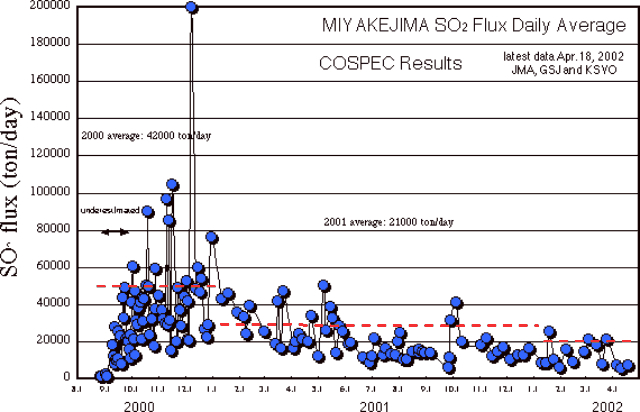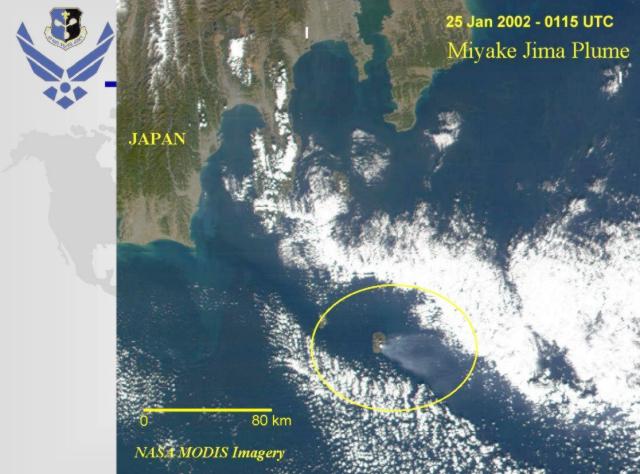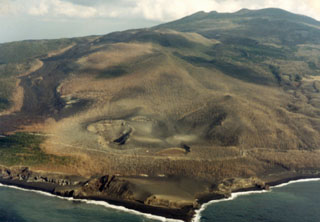Report on Miyakejima (Japan) — March 2002
Bulletin of the Global Volcanism Network, vol. 27, no. 3 (March 2002)
Managing Editor: Richard Wunderman.
Miyakejima (Japan) Eruptive activity decreases; high SO2 flux through April 2002
Please cite this report as:
Global Volcanism Program, 2002. Report on Miyakejima (Japan) (Wunderman, R., ed.). Bulletin of the Global Volcanism Network, 27:3. Smithsonian Institution. https://doi.org/10.5479/si.GVP.BGVN200203-284040
Miyakejima
Japan
34.094°N, 139.526°E; summit elev. 775 m
All times are local (unless otherwise noted)
The following report covers activity at Miyake-jima after February 2001 and through April 2002, but a brief review of previous activity is included. Volcanism renewed at Miyake-jima on 27 June 2000 with a series of underwater eruptions (BGVN 25:05-25:07). Activity through October 2000 was characterized by intrusive events, collapse of the summit crater, explosive events, and degassing. SO2 emissions were high and low levels of ash were intermittently emitted (BGVN 25:09). During October 2000 through mid-February 2001 high volumes of volcanic gas emission continued (BGVN 26:02).
After a large eruption on 18 August 2000, large amounts of volcanic gas, especially SO2, started to discharge. SO2 flux monitoring by COSPEC V has been conducted since 26 August 2000. Monitoring is performed almost daily by the Japanese Meteorological Agency (JMA) and Geological Survey of Japan (GSJ). Figure 14 shows the daily average of SO2 flux during August 2000 through April 2002. The mean flux during September-December 2000 was ~40,000 metric tons per day (t/d). During 2000, the average SO2 flux was 40,000 t/d, and it decreased to 21,000 t/d during 2001. As of March 2002 the average SO2 flux was 10,000-20,000 t/d. During the 26 September 2001 explosion the amount of SO2 degassing was ~15,000 t/d.
 |
Figure 14. Daily averages of SO2 flux at Miyake-jima during August 2000 through April 2002. Courtesy JMA, GSJ, and KSVO. |
In November 2001 the GSJ reported that the strong eruptions of July-August 2000, initially thought to be solely phreatic, had been phreatomagmatic. For instance, tephra from the 18 August 2000 eruption was ~30-40% juvenile in nature. Following the 29 August 2000 eruption, activity was much weaker. A summit pit crater or caldera, formed as a result of "drain back" as magma was intruded elsewhere, stabilized in August 2000 with a diameter of 1.4 km.
On 16 March 2001 the JMA reported that the strongest tremor since 29 August 2000 had occurred. Three days later, on 19 March, an eruption produced a black ash cloud that rose 800 m above the volcano.
In mid-May 2001, based on information from the JMA, the Volcanic Research Center reported that no ash clouds had been observed since 19 March. They also reported that steam plumes with abundant SO2 were continuously emitted from the summit caldera to 0.5-2 km above the caldera rim. Continuous SO2 emission released as much as 33,000 to 46,000 metric tons of SO2 per day (figure 14). Low-level seismic activity continued; on 5 May 2001 a total of 446 small low-frequency earthquakes were registered, and on 7 May an M 2.8 earthquake occurred. Global positioning system (GPS) measurements showed steady, continuous deflation of the volcano, though the rate was lower than before September 2000. Very small collapses of the caldera rims were occasionally seen during air inspections.
About 20 small eruptions were recorded by the JMA during 2001 through the end of March 2002. Major eruptions were reported on 27 May, 26-27 September, and 16 October 2001. The eruptions produced ash plumes up to 1,500 m high.
On 25 January 2002 at 1015 Air Force Weather Agency staff detected a faint E-drifting volcanic plume emanating from Miyake-jima on MODIS imagery (figure 15).
 |
Figure 15. MODIS imagery on 25 January 2002 at 1015 shows a plume drifting E from Miyake-jima. Courtesy AFWA and NASA. |
The GSJ reported that as of 1 April 2002, eruptions were continuing and significant quantities of SO2 (10,000-20,000 t/d) discharged from the summit pit crater (figure 14). According to a news report, a minor eruption occurred at Miyake-jima on 2 April shortly after 1000. While evacuated residents were visiting the island, ash rose to ~300 m above the volcano and fell around Miyake-jima. The island is currently uninhabited because activity that began on 26-27 June 2000 prompted officials to order an evacuation on 1 September 2000.
Geological Summary. The circular, 8-km-wide island of Miyakejima forms a low-angle stratovolcano that rises about 1,100 m from the sea floor in the northern Izu Islands about 200 km SSW of Tokyo. The basaltic volcano is truncated by small summit calderas, one of which, 3.5 km wide, was formed during a major eruption about 2,500 years ago. Numerous craters and vents, including maars near the coast and radially oriented fissure vents, are present on the flanks. Frequent eruptions have been recorded since 1085 CE at vents ranging from the summit to below sea level, causing much damage on this small populated island. After a three-century-long hiatus ending in 1469 CE, activity has been dominated by flank fissure eruptions sometimes accompanied by minor summit eruptions. A 1.6-km-wide summit crater was slowly formed by subsidence during an eruption in 2000.
Information Contacts: Japan Meteorological Agency (JMA), Volcanological Division, 1-3-4 Ote-machi, Chiyoda-ku, Tokyo 100, Japan (URL: http://www.jma.go.jp/); Setsuya Nakada and Hidefumi Watanabe, Volcano Research Center, Earthquake Research Institute, University of Tokyo, Yayoi 1-1-1, Bunkyo-ku, Tokyo 113-0032, Japan (URL: http://www.eri.u-tokyo.ac.jp/VRC/index_E.html); Akihiko Tomiya, Geological Survey of Japan (GSJ), National Institute of Advanced Industrial Science and Technology (AIST), Tsukuba Central 7, Tsukuba 305-8567, Japan (URL: http://staff.aist.go.jp/a.tomiya/miyakeE.html); Charles Holliday, Air Force Weather Agency (AFWA),106 Peacekeeper Dr., Ste 2NE; Offutt AFB, NE 68113-4039 USA; National Aeronautics and Space Administration (NASA), Washington, DC 20456-0001, USA (URL: https://www.nasa.gov/); Kusatsu-Shirane Volcano Observatory (KSVO), Tokyo Institute of Technology, Kusatsu, Agatsuma-gun, Gunma 377-17, Japan; Dow Jones News.

